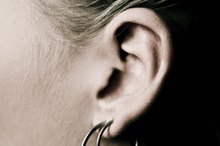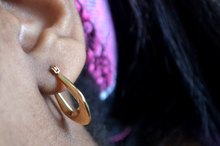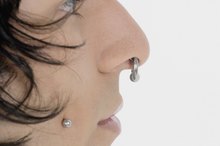What does fact checked mean?
At Healthfully, we strive to deliver objective content that is accurate and up-to-date. Our team periodically reviews articles in order to ensure content quality. The sources cited below consist of evidence from peer-reviewed journals, prominent medical organizations, academic associations, and government data.
The information contained on this site is for informational purposes only, and should not be used as a substitute for the advice of a professional health care provider. Please check with the appropriate physician regarding health questions and concerns. Although we strive to deliver accurate and up-to-date information, no guarantee to that effect is made.
What Are the Dangers of Pierced Ears?
Ear piercings are one of the most common types of body piercings; they are also considered to be one of the safest types. However, just like any other piercing, they come with risks 1. Seeking a licensed professional to pierce your ears is the best way to avoid the risks of infection and allergic reaction.
Bacterial Infection
A bacterial infection can result from the use of dirty needles during the piercing process. Make sure that the professional who is piercing your ears uses clean, sterilized needles, and avoid touching the new piercing. Follow the piercing professional's instructions for careful cleansing and care after piercing. This may include using antibacterial products and washing your hands beforehand.
- A bacterial infection can result from the use of dirty needles during the piercing process.
Other Types of Infection
How to Prevent Infection in Pierced Ears
Learn More
Piercing also brings the risk of developing an abscess; this occurs when pus becomes trapped under the skin, just above the cartilage. Antibiotics can be prescribed to help with this type of infection; in severe cases, surgery may be required. The use of unclean needles can also lead to transmission of HIV or hepatitis.
Allergic Reaction
Sometimes the type of jewelry worn in a new piercing can cause allergic reactions on the skin. A safe bet is to avoid earrings made of nickel or brass, to which allergic reactions are common.
Related Articles
References
- National Health Service: Body Piercing - Risks
- Family Doctor: Body Piercing
- National Conference of State Legislatures. Tattooing and body piercing | state laws, statutes and regulations. March 13, 2019.
- Koenig, L. M., & Carnes, M. (1999). Body Piercing: Medical Concerns with Cutting-Edge Fashion. Journal of General Internal Medicine, 14(6), 379–385.
- Palo Alto Medical Foundation, Body Piercing
- National Conference of State Legislatures. Tattooing and body piercing | state laws, statutes and regulations. March 13, 2019.
- American Academy of Pediatrics. HealthyChildren.org. Body piercings, teens & potential health risks: AAP report explained. Updated September 18, 2017.
- Johns Hopkins All Children’s Hospital. Adolescent tattoos, body piercings and body modifications. November 21, 2017.
- Koenig, L. M., & Carnes, M. (1999). Body Piercing: Medical Concerns with Cutting-Edge Fashion. Journal of General Internal Medicine, 14(6), 379–385.
- Palo Alto Medical Foundation, Body Piercing
Writer Bio
Jae Allen has been a writer since 1999, with articles published in "The Hub," "Innocent Words" and "Rhythm." She has worked as a medical writer, paralegal, veterinary assistant, stage manager, session musician, ghostwriter and university professor. Allen specializes in travel, health/fitness, animals and other topics.









